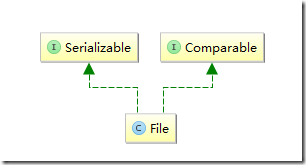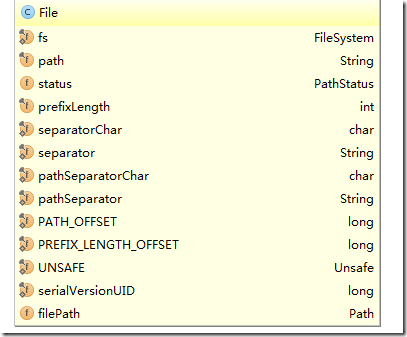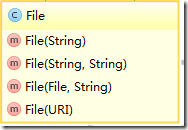一、简介
File类是“文件”和“目录名”的抽象表示形式。因此在java语言中,File类既可以表示文件也可以表示目录。
尽管java.io定义的大多数类是实行流式操作的,而File类则不是,它没有指定信息怎样从文件读取或向文件存储。File描述了文件本身的属性,直接处理文件和文件系统,是唯一一个与文件本身有关的操作。
1.1 File的继承与实现接口
File 直接继承于Object,实现了Serializable接口和Comparable接口。
public class File implements Serializable, Comparable<File>
- File类实现Serializable接口,意味着File对象支持序列化操作。
- File类实现Comparable接口,意味着File对象之间可以比较大小,此外File能直接被存储在有序集合(如TreeSet、TreeMap中)。
1.2 File使用注意事项
1、创建File类对象时要注意的地方
1.3 File的常见方法
1)判断文件或者目录是否存在: exists()
2)判断是否为目录: isDirectory()
3)判断是否为文件: isFile()
4)判断文件是否可读: canRead()
5)判断文件是否可写: canWrite()
6)判断文件是否隐藏: isHidden()
7)判断文件路径是否为绝对路径: isAbsolute()
8)判断文件路径是否相同: equals():返回true,false
compareTo():是否相等,相等返回0,小于返回负数,大于返回正数
9)获取文件的绝对路径: getAbsolutePath()
10)获取文件名称: getName()
11)获取文件大小: length()
12)获取文件最后被修改的时间 : lastModified()
13)获取文件的路径: getPath()
14)获取文件的上层文件的目录: getParent()
15)创建一个新文件: createNewFile()
16)创建一个新目录: mkdir()
17)删除文件或目录: delete()
18)修改文件的名称: renameTo(str)
19)修改文件为只读: setReadOnly()
20)修改最后的修改时间: setLastModified(long time)
二、源码分析
2.1 成员变量
// The FileSystem object representing the platform's local file system.
// 获取本地文件系统
private static final FileSystem fs = DefaultFileSystem.getFileSystem();
// 文件路径名
private final String path;
// 标记文件路径是否无效
private transient PathStatus status = null;
// The length of this abstract pathname's prefix, or zero if it has no prefix.
private final transient int prefixLength;
/**
* The system-dependent default name-separator character. This field is
* initialized to contain the first character of the value of the system
* property <code>file.separator</code>. On UNIX systems the value of this
* field is <code>'/'</code>; on Microsoft Windows systems it is <code>'\'</code>.
*
*/
public static final char separatorChar = fs.getSeparator();
// The system-dependent path-separator character, represented as a string for convenience.
public static final String pathSeparator = "" + pathSeparatorChar;
其实是根据不同的平台,安装不同版本的JDK,根据平台下对应版本的JDK,加载本地文件系统。
解决了fs这个成员变量,那么separatorChar 这个成员变量就迎刃而解了。
2.2 构造函数
1、首先看看整体如下:
public File(String pathname) {该构造方法主要是初始化了path、prefixLength两个成员变量,其中path通过WinNTFileSystem中normalize 公开方法将其规范化。
if (pathname == null) {
throw new NullPointerException();
}
this.path = fs.normalize(pathname);
this.prefixLength = fs.prefixLength(this.path);
}
public static void main(String[] args)
{
File file = new File("d:/test.txt");
System.out.println(file.getPath());
}
File:
public String getPath() {
return path;
}
2)File(File parent, String child)
public File(File parent, String child) {
if (child == null) {
throw new NullPointerException();
}
if (parent != null) {
if (parent.path.equals("")) {
this.path = fs.resolve(fs.getDefaultParent(),
fs.normalize(child));
} else {
this.path = fs.resolve(parent.path,
fs.normalize(child));
}
} else {
this.path = fs.normalize(child);
}
this.prefixLength = fs.prefixLength(this.path);
}
2.3 创建操作
- createNewFile
- createTempFile
- mkdir
1)createNewFile()
public boolean createNewFile() throws IOException {
// 1、检查是否有权限对该文件进行操作
SecurityManager security = System.getSecurityManager();
if (security != null) security.checkWrite(path);
// 2、检查文件路径是否有效
if (isInvalid()) {
throw new IOException("Invalid file path");
}
// 3、在Windows中,调用WinNTFileSystem中createFileExclusively方法,该方法是调用系统底层方法。
return fs.createFileExclusively(path);
}
// 此方法创建此抽象路径名的目录。
public boolean mkdir() {
SecurityManager security = System.getSecurityManager();
if (security != null) {
security.checkWrite(path);
}
if (isInvalid()) {
return false;
}
return fs.createDirectory(this);
}
2.4 删除操作
- delete
- deleteOnExit
public boolean delete() {
// 1、权限检查
SecurityManager security = System.getSecurityManager();
if (security != null) {
security.checkDelete(path);
}
// 2、检查文件路径是否有效
if (isInvalid()) {
return false;
}
// 3、调用系统本地底层删除方法,
// 不过在删除之前做了一些清理,cache.clear();prefixCache.clear();
return fs.delete(this);
}
2.5 获取文件操作
// Returns the absolute form of this abstract pathname. Equivalent to new File(this.getAbsolutePath()).
public File getAbsoluteFile() {
String absPath = getAbsolutePath();
return new File(absPath, fs.prefixLength(absPath));
}
// Returns the canonical form of this abstract pathname. Equivalent to new File(this.getCanonicalPath()).
public File getCanonicalFile() throws IOException {
String canonPath = getCanonicalPath();
return new File(canonPath, fs.prefixLength(canonPath));
}
// 此方法返回此抽象路径名的绝对路径名字符串。
public String getAbsolutePath() {
return fs.resolve(this);
}
// 此方法返回此抽象路径名的规范路径名字符串。
public String getCanonicalPath() throws IOException {
if (isInvalid()) {
throw new IOException("Invalid file path");
}
return fs.canonicalize(fs.resolve(this));
}
// 此方法此抽象路径名转换为一个路径名字符串。4)getParent()
// Converts this abstract pathname into a pathname string
// 此处pathname与File(String pathname)中pathname一致
public String getPath() {
return path;
}
// 此方法返回此抽象路径名的父路径名的字符串,或者null,如果此路径名没有指定父目录。
public String getParent() {
// 查找最后分隔符的位置
int index = path.lastIndexOf(separatorChar);
if (index < prefixLength) {
if ((prefixLength > 0) && (path.length() > prefixLength))
return path.substring(0, prefixLength);
return null;
}
// 获取最后分隔符之前的所有字符
return path.substring(0, index);
}



![S[KM1N]}PTOAHEH_LLMCOZF S[KM1N]}PTOAHEH_LLMCOZF](https://images2015.cnblogs.com/blog/530090/201509/530090-20150917202424773-928530956.png)
